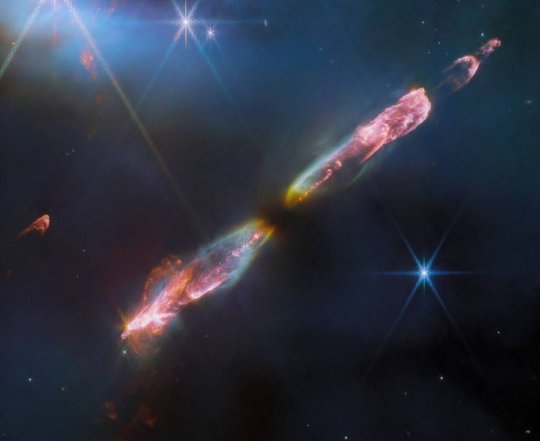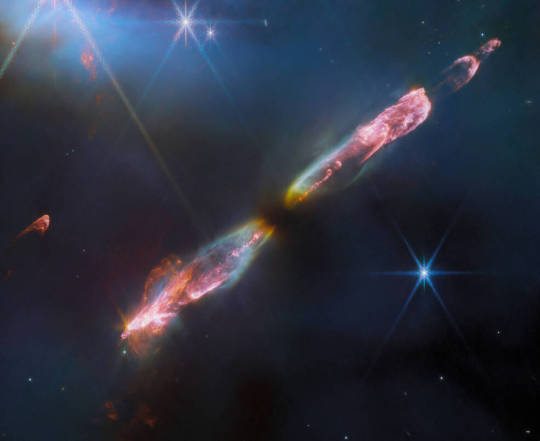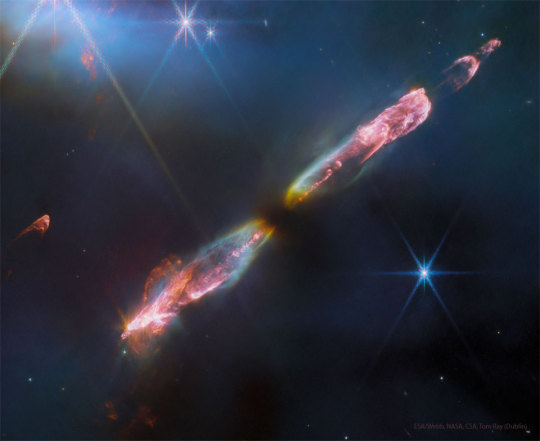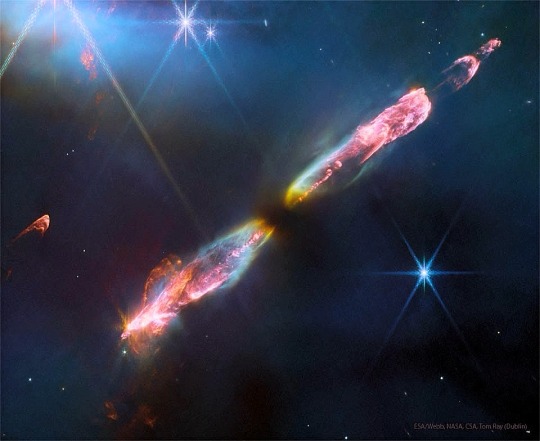#herbig haro 211
Text

Herbig-Haro 211 from Webb: detail of the outflow of a young star, an infantile analogue of our Sun
#nasa#webb#herbig haro#HH 211#JWST#astrophotography#james webb telescope#stars#sky#space#galaxy#astronomy#universe
819 notes
·
View notes
Text

Herbig-Haro 211
This image from the James Webb Space Telescope shows jets of gas flowing from an infant star that will grow up to be like our sun. For now, its jets strike surrounding gas and dust, creating shockwaves.
#art#cosmos#cosmic#universe#blast#space#photography#stars#nasa#herbig-haro 211#tantrum#james webb space telescope#gas#shockwaves
112 notes
·
View notes
Text

NASA’s Webb Snaps Supersonic Outflow of Young Star
NASA’s James Webb Space Telescope’s high resolution, near-infrared look at Herbig-Haro 211 reveals exquisite detail of the outflow of a young star, an infantile analogue of our Sun. Herbig-Haro objects are formed when stellar winds or jets of gas spewing from newborn stars form shock waves colliding with nearby gas and dust at high speeds. The image showcases a series of bow shocks to the southeast (lower-left) and northwest (upper-right) as well as the narrow bipolar jet that powers them in unprecedented detail. Molecules excited by the turbulent conditions, including molecular hydrogen, carbon monoxide and silicon monoxide, emit infrared light, collected by Webb, that map out the structure of the outflows.
Credits: ESA/Webb, NASA, CSA, T. Ray (Dublin Institute for Advanced Studies).
#james webb telescope#james webb space telescope#james webb photos#james webb images#NASA’s Webb Snaps Supersonic Outflow of Young Star#Herbig-Haro 211#space#nasa#nasa photos#nasa picture of the day#pretty#beauty#beautiful
25 notes
·
View notes
Text

NASA’s James Webb Space Telescope’s high resolution, near-infrared look at Herbig-Haro 211 reveals exquisite detail of the outflow of a young star, an infantile analogue of our Sun. Herbig-Haro objects are formed when stellar winds or jets of gas spewing from newborn stars form shock waves colliding with nearby gas and dust at high speeds.
Credits: ESA/Webb, NASA, CSA, T. Ray (Dublin Institute for Advanced Studies)
3K notes
·
View notes
Photo

2023 September 19
HH 211: Jets from a Forming Star
Credit: NASA, ESA, CSA, Webb; Processing: Tom Ray (DIAS Dublin)
Explanation: Do stars always create jets as they form? No one is sure. As a gas cloud gravitationally contracts, it forms a disk that can spin too fast to continue contracting into a protostar. Theorists hypothesize that this spin can be reduced by expelling jets. This speculation coincides with known Herbig-Haro (HH) objects, young stellar objects seen to emit jets -- sometimes in spectacular fashion. Pictured is Herbig-Haro 211, a young star in formation recently imaged by the Webb Space Telescope (JWST) in infrared light and in great detail. Along with the two narrow beams of particles, red shock waves can be seen as the outflows impact existing interstellar gas. The jets of HH 221 will likely change shape as they brighten and fade over the next 100,000 years, as research into the details of star formation continues.
∞ Source: apod.nasa.gov/apod/ap230919.html
204 notes
·
View notes
Text

SPACEMAS DAY 4 ✨🪐🌎☄️☀️🌕
Do stars always create jets as they form? No one is sure. As a gas cloud gravitationally contracts, it forms a disk that can spin too fast to continue contracting into a protostar. Theorists hypothesize that this spin can be slowed by expelling jets. This speculation coincides with known Herbig-Haro (HH) objects, young stellar objects seen to emit jets. Pictured is Herbig-Haro (HH) 211, a young star in formation recently imaged by the James Webb Space Telescope (JWST) in infrared light and in great detail. Along with the two narrow beams of particles, red shock waves can be seen. The jets of HH 211 will likely change shape as they brighten and fade over the next 100,000 years, as research into the details of star formation continues.
Image Credit: ESA/NASA, JWST
#astronomy#space#science#universe#spacemas#day 4#star#formation#jets#spin#interstellar#interstellar gas#gravity#star formation#colours#infrared#shock waves#follow#like#reblog#the first star#the first starr#thefirststar#thefirststarr#nasa#apod#tumblr#blog#hh object#herbig haro 211
78 notes
·
View notes
Text
Discovery Alert! In a new discovery released on September 14, 2023, James Webb Telescope reveals A Close-Up of Stellar Birth in HH 211. Read full article here

Prepare to be captivated by the breathtaking beauty of space! NASA's James Webb Space Telescope has gifted us with a mesmerizing glimpse into the birth of celestial bodies, courtesy of Herbig-Haro 211 (HH 211). This cosmic wonder resembles the early days of our own Sun and offers invaluable insights into star formation.
🌟 Herbig-Haro objects are cosmic masterpieces born when stellar winds and gas jets from newborn stars collide with nearby interstellar matter at astonishing speeds. In Webb's high-resolution, near-infrared image, HH 211 shines with exquisite detail, showcasing a series of dazzling bow shocks to the southeast and northwest. But that's not all—this image unveils a slender bipolar jet that powers these shocks in unprecedented detail.
💫 What makes this image even more fascinating is the dance of molecules within this turbulent environment. Molecular hydrogen, carbon monoxide, silicon monoxide, and more become electrified, emitting infrared light that Webb artfully captures. This light provides a map of the intricate structure of the celestial outflows.
📸 Credits go to ESA/Webb, NASA, CSA, and T. Ray from the Dublin Institute for Advanced Studies for this celestial masterpiece.
Ready to embark on a cosmic journey? Dive into the full article and explore the cosmic wonders Webb has unveiled: here
#NASA #WebbTelescope #StellarBirth #CosmicWonders #SpaceDiscovery #Astronomy #HerbigHaro211 🚀🌠
26 notes
·
View notes
Photo

Stunning James Webb Space Telescope image shows young star blasting supersonic jets | Space
NASA’s James Webb Space Telescope’s high resolution, near-infrared look at Herbig-Haro 211 reveals exquisite detail of the outflow of a young star, an infantile analogue of our sun. (Image credit: ESA/Webb, NASA, CSA, Tom Ray (Dublin))
23 notes
·
View notes
Text

"NASA’s James Webb Space Telescope’s high resolution, near-infrared look at Herbig-Haro 211 reveals exquisite detail of the outflow of a young star, an infantile analogue of our Sun. Herbig-Haro objects are formed when stellar winds or jets of gas spewing from newborn stars form shock waves colliding with nearby gas and dust at high speeds
The image showcases a series of bow shocks to the southeast (lower-left) and northwest (upper-right) as well as the narrow bipolar jet that powers them in unprecedented detail. Molecules excited by the turbulent conditions, including molecular hydrogen, carbon monoxide and silicon monoxide, emit infrared light, collected by Webb, that map out the structure of the outflows."
HH 211 (NIRCam Image), Webb telescope, ESA/Webb, NASA, CSA, Tom Ray (Dublin)
8 notes
·
View notes
Text
Infant Star Burning Bright

NASA’s James Webb Space Telescope’s high resolution, near-infrared look at Herbig-Haro 211 reveals exquisite detail of the outflow of a young star, an infantile analogue of our Sun. Herbig-Haro objects are formed when stellar winds or jets of gas spewing from newborn stars form shock waves colliding with nearby gas and dust at high speeds. The image showcases a series of bow shocks to the southeast (lower-left) and northwest (upper-right) as well as the narrow bipolar jet that powers them in unprecedented detail. Molecules excited by the turbulent conditions, including molecular hydrogen, carbon monoxide and silicon monoxide, emit infrared light, collected by Webb, that map out the structure of the outflows
Source: ESA/Webb, NASA, CSA, T. Ray (Dublin Institute for Advanced Studies)
#jwst#jwst images#james webb space telescope#webb telescope#james webb photos#astronomy#nasa#nasa image of the day#nasawebb
9 notes
·
View notes
Text
Une image de Herbig-Haro 211, une étoile bébé
Nouvel article publié sur https://www.2tout2rien.fr/une-image-de-herbig-haro-211-une-etoile-bebe/
Une image de Herbig-Haro 211, une étoile bébé

4 notes
·
View notes
Text




decided 2 look up newer jwst images before bed....ough...
1) crab nebula
2) herbig-haro (hh) 797
3) herbig-haro (hh) 211
4) rho ophiuchi
1 note
·
View note
Text

Webb captures a prominent protostar in Perseus
This new Picture of the Month from the NASA/ESA/CSA James Webb Space Telescope reveals intricate details of the Herbig Haro object 797 (HH 797). Herbig-Haro objects are luminous regions surrounding newborn stars (known as protostars), and are formed when stellar winds or jets of gas spewing from these newborn stars form shockwaves colliding with nearby gas and dust at high speeds.
HH 797, which dominates the lower half of this image, is located close to the young open star cluster IC 348, which is located near the eastern edge of the Perseus dark cloud complex. The bright infrared objects in the upper portion of the image are thought to host two further protostars.
This image was captured with Webb's Near-InfraRed Camera (NIRCam). Infrared imaging is powerful in studying newborn stars and their outflows, because the youngest stars are invariably still embedded within the gas and dust from which they are formed. The infrared emission of the star's outflows penetrates the obscuring gas and dust, making Herbig-Haro objects ideal for observation with Webb's sensitive infrared instruments.
Molecules excited by the turbulent conditions, including molecular hydrogen and carbon monoxide, emit infrared light that Webb can collect to visualize the structure of the outflows. NIRCam is particularly good at observing the hot (thousands of degrees Celsius) molecules that are excited as a result of shocks.
Using ground-based observations, researchers have previously found that for the cold molecular gas associated with HH 797, most of the red-shifted gas (moving away from us) is found to the south (bottom right), while the blue-shifted gas (moving towards us) is to the north (bottom left). A gradient was also found across the outflow, such that at a given distance from the young central star, the velocity of the gas near the eastern edge of the jet is more red-shifted than that of the gas on the western edge.
Astronomers in the past thought this was due to the outflow's rotation. In this higher-resolution Webb image, however, we can see that what was thought to be one outflow is in fact made up of two almost parallel outflows with their own separate series of shocks (which explains the velocity asymmetries). The source, located in the small dark region (bottom right of center), and already known from previous observations, is therefore not a single but a double star. Each star is producing its own dramatic outflow. Other outflows are also seen in this image, including one from the protostar in the top right of center along with its illuminated cavity walls.
HH 797 resides directly north of HH 211 (separated by approximately 30 arcseconds), which was the feature of a Webb image release in September 2023.
IMAGE....In the lower half of the image is a narrow, horizontal nebula that stretches from edge to edge. It is brightly colored with more variety on its right side. In the upper half there is a glowing point with multi-colored light radiating from it in all directions. A bright star with long diffraction spikes lies along the right edge, and a few smaller stars are spread around. The background is covered in a thin haze. Credit: ESA/Webb, NASA & CSA, T. Ray (Dublin Institute for Advanced Studies)
1 note
·
View note
Text
0 notes
Text
youtube
This JWST photo of Herbig Haro 211 shows us what a sunlike protostar, still in its infancy, looks like. 💫
0 notes
